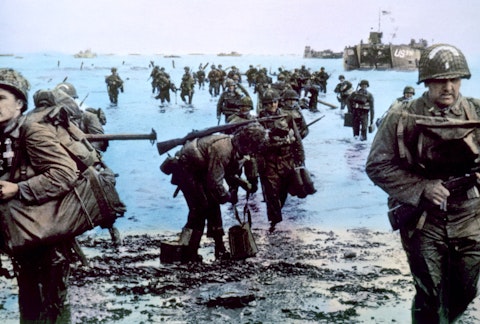This article looks at the 7 most powerful countries before World War 2 and dives into one of the deadliest conflicts in human history. You can skip our detailed analysis and go directly to the 5 Most Powerful Countries Before World War 2.
Deadliest Conflict in Human History
World War II was the biggest and deadliest war in human history, lasting six years, and involving more than 30 countries. While the battle was primarily fought in Europe and expanded to the Pacific, its impact was also felt globally, including in North Africa, where military campaigns in Egypt, Libya, Morocco, Tunisia, and Algeria resulted in thousands of deaths. The war was fought between two alliances – the Allies led by Great Britain, the United States, France, and the Soviet Union, and the Axis Powers, spearheaded by Germany, Italy, and Japan.
An estimated 50-85 million people lost their lives in World War 2, with more property and land damaged than in any other previous wars. The catastrophe included at least 6 million Jews getting murdered in Hitler’s concentration camps as part of the Holocaust, coupled with the planned ethnic cleansing of the Romani people during the same time, in which between 150,000 to 250,000 people were killed. This was also the first and only conflict in history, in which nuclear weapons were used when the United States launched strikes on Hiroshima and Nagasaki in 1945 that maimed and killed hundreds of thousands of people.
READ ALSO: 20 Most Powerful Countries Ruling the World in 2050 and 15 Countries that will have the Most Powerful Militaries by 2030.
The conflict started in Europe in 1939 with Germany invading Poland. This resulted in both Great Britain and France declaring war against the Germans. Two years later, Germany invaded the Soviet Union, and the war entered the Pacific during the same year with Japan’s attack on Pearl Harbour in December 1941, which officially dragged the United States to become an active player in both the European and Pacific theaters. The war lingered on for six years until 1945 when the Allies defeated Nazi Germany and Japan.
America in World War 2
The United States declared war on Japan after the Pearl Harbour attack in 1941. This was followed by Italy and Germany’s declaration of war against the United States, which resulted in the nation becoming fully engulfed in the conflict. Washington’s involvement in the war led to a mass mobilization effort, involving millions of men and women, including citizen soldiers, serving their country overseas by joining the armed forces. More than 330,000 American soldiers lost their lives in the war.
Those who could not join militarily played their part and supported the war efforts through other means. Several industrialists retooled their parts to manufacture war goods. Housewives and women working outside the defense industry started working in plants that produced aircraft, munition, military uniforms, etc. The increasing demand for steel to support the war was met by Americans through scrap metal drives and rationing programs. Several citizens also purchased Liberty Bonds from the government to raise funds for the war.
This mobilization revitalized America’s idle economy, creating around 17 million new jobs. Industrial productivity rose 96%, increasing the supply of consumer goods. Corporate profits after taxes increased by 50% compared to 1939, and workers’ wages before taxes too doubled from 1939. A large number of women and Blacks also entered the workforce. There was a realization among American citizens that the war was being fought for common men and women, and that the veterans should return to a stable economy with ample economic opportunities available to them.
A major expansion was witnessed in America’s aerospace industry. According to the Air Force Historical Research Agency, the US Army Air Force’s strength grew from a mere 2,200 aircraft and over 26,000 men in 1939 to a staggering 63,715 aircraft and 2.3 million personnel by 1945. As far as overall military aircraft are concerned, the country produced 300,017 of those between 1940 and 1945, aided by several factories that ran 24 hours a day, seven days a week.
Various bombers and fighter jets were used by the US during the war. Consolidated Aircraft’s B-24 heavy bomber was a workhorse, with about 18,000 of these being built between 1940 and 1945. This is one of the most produced heavy bombers and American military aircraft in history. The B-24 had an effective shoulder-mounted Davis swing that provided the aircraft the ability to cruise at high speeds and carry heavy bomb loads.
In 1940 President Roosevelt announced that his country would have to mass-produce combat aircraft over the next year to prepare for the challenges ahead. With Consolidated Aircraft lacking the resources and capacity to build the B-24 at that pace, the War Department chose the Ford Motor Company (NYSE:F) to manufacture them. Among all B-24s produced during WW2, nearly half of them were made by the automobile giant.
While critics initially scoffed at the decision, Ford Motor Company (NYSE:F) proved them wrong over time. The company manufactured 8,675 B-24 Liberators over the next two and a half years in a 3.5m square foot plant in Willow Run, compared to 9,808 built by four factories of Consolidated, North American Aviation, and Douglas Aircraft combined. At one point in mid-1944, Ford Motor Company (NYSE:F) was manufacturing one B-24 per hour. The company to date is acclaimed for its role in helping the Allied Powers win the war.
Another heavy hitter used by the US during the war was the B-17 Flying Fortress. The four-engined bomber was built by The Boeing Company (NYSE:BA) in 1935 and was introduced in 1938. It is famed for having dropped more bombs during World War 2 than any other American aircraft. The Boeing Company (NYSE:BA) also produced the B-29 Superfortress, which was designed for high-altitude heavy bombing but also proved useful in low-altitude bombing. It was used by the United States to blockade Japan and also dropped the nuclear bombs in Hiroshima and Nagasaki.
The Boeing Company (NYSE:BA) continues to be a leading aerospace company that produces commercial aircraft, space systems, and defense equipment for countries worldwide. As of 2022, it is the fifth largest defense contractor in the world, with defense-related sales worth $31 billion during the year. However, the company has come under some pressure lately after a door plug of an Alaska Airlines 737 Max 9 flight fell off after takeoff in January. As a result, it reported a net loss of $355 million during the first quarter of 2024. While the financial results were down, they were not as bad as industry analysts had forecast.
The company beat analysts’ earning forecasts and posted a negative EPS of -$0.56 against the anticipated -$1.43. This reflected the aerospace giant’s resilience amid challenges as well as signs of a resurgence across the aviation industry. Moreover, experts believe that it is too big a company to fail, and with a backlog of orders worth $500 billion and international travel growing every year, The Boeing Company (NYSE:BA) is likely to turn things around in 2025 after the headwinds are over. According to Insider Monkey, 54 hedge funds were bullish about the company’s prospects as of the first quarter of 2024.
While we acknowledge the potential of The Boeing Company (NYSE:BA) as an investment, our conviction lies in the belief that some AI stocks hold greater promise for delivering higher returns and doing so within a shorter time frame. If you are looking for an AI stock that is more promising than The Boeing Company (NYSE:BA) but that trades at less than 5 times its earnings, check out our report about the cheapest AI stock.

Everett Historical/Shutterstock.com
Methodology
While the major combatants of World War 2 and the war’s outcome are well known, there is little written material available that ranks countries based on their strength before the start of the war. For this purpose, we studied several articles and publications related to the subject. After carefully analyzing each power’s strengths on the eve of the conflict, we have listed the most powerful countries before World War 2 in ascending order.
At Insider Monkey we are obsessed with the stocks that hedge funds pile into. The reason is simple: our research has shown that we can outperform the market by imitating the top stock picks of the best hedge funds. Our quarterly newsletter’s strategy selects 14 small-cap and large-cap stocks every quarter and has returned 275% since May 2014, beating its benchmark by 150 percentage points. (see more details here).
Let’s now head over to the list of the most powerful countries before World War 2.
Here are the Most Powerful Countries Before World War 2:
7. Italy
Italy was part of the Axis alliance during World War 2 which comprised Germany and Japan as the other countries. Ruled by Mussolini, the country was part of the alliance’s quest for territorial expansion, and in October 1935, seized Ethiopia. The fascist leader believed that Italy needed outlets beyond its borders for its ‘surplus population’, and aspired to political hegemony in the Mediterranean, Danubian, and Balkan regions. This aggression left Italy with few friends outside of its borders and brought the country further close to like-minded regimes in Germany and Japan. Before the beginning of the Great War, Italy signed several military cooperation pacts with both of these nations. Italy was considered one of the most powerful countries before World War 2.
6. France
France was one of the most powerful countries before World War 2, with a large, well-trained military that recovered much of the territories lost in 1918 and held colonial control over much of Central, North, and West Africa. As of 1935, the French armed forces had 320,000 troops stationed at home, with 210,000 others in North Africa, Syria, and other French colonies. The country’s air force was also well-equipped with 463 bombers, 634 fighter jets, and 444 reconnaissance aircraft, as of September 1939 when the war broke out. Moreover, the French army had around 90 infantry divisions.
5. Japan
Japan was one of the most powerful countries before World War 2. Under the Meiji Restoration, which started in 1868, Japan rapidly transformed itself into a major power through modernization and the adoption of Western technologies, while at the same time upholding its own values and traditions. With an ambition to ‘free Asia’ from Western influence, Japan turned into an imperial power in 1895 with the territorial acquisition of Taiwan, and then later Manchuria, Korea, and parts of China. The Japanese military had an estimated manpower of 1.7 million personnel before the conflict started. On the naval front, the country had 10 battleships, 6 aircraft carriers, 65 submarines, 112 destroyers, 18 heavy cruisers, and over 2,200 combat aircraft.





